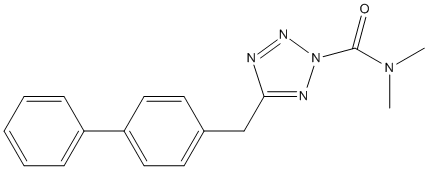AM6701
Compound that inhibits MGLL ABHD6 and strong inhibitor of FAAH (not an alpha/beta hydrolase). MGL inhibition by AM6701 involves a covalent interaction resulting in the enzyme's rapid, selective carbamoylation at active site serine (Ser122), slowly reversible inhibition. Formula close to LY2183240
General
Type : Biphenyl,Urea derivative,Cannabinoid-Receptor-ligand,FAAH inhibitor,Multitarget,Carboxamide,Tetrazol
Chemical_Nomenclature : ~{N},~{N}-dimethyl-5-[(4-phenylphenyl)methyl]tetrazole-2-carboxamide
Canonical SMILES : CN(C)C(=O)N1N=C(N=N1)CC2=CC=C(C=C2)C3=CC=CC=C3
InChI : InChI=1S\/C17H17N5O\/c1-21(2)17(23)22-19-16(18-20-22)12-13-8-10-15(11-9-13)14-6-4-3-5-7-14\/h3-11H,12H2,1-2H3
InChIKey : VBVLSXPOMAONNK-UHFFFAOYSA-N
Other name(s) : AM-6701,CHEMBL485841,1010096-65-7,2H-Tetrazole-2-carboxamide, 5-([1,1'-biphenyl]-4-ylmethyl)-N,N-dimethyl-,5-([1,1'-Biphenyl]-4-ylmethyl)-N,N-dimethyl-2H-tetrazole-2-carboxamide,5-((biphenyl-4-yl)methyl)-N,N-dimethyl-2H-tetrazole-2-carboxamide
MW : 307.35
Formula : C17H17N5O
CAS_number :
PubChem : 24795576
UniChem : VBVLSXPOMAONNK-UHFFFAOYSA-N
IUPHAR :
Wikipedia :

Target
Families : AM6701 ligand of proteins in family: ABHD6-Lip || Monoglyceridelipase_lysophospholip
Stucture :
Protein : human-ABHD6 || human-MGLL
References (4)
| Title : Biochemical and Proteomic Characterization of Recombinant Human alpha\/beta Hydrolase Domain 6 - Shields_2019_Sci.Rep_9_890 |
| Author(s) : Shields CM , Zvonok N , Zvonok A , Makriyannis A |
| Ref : Sci Rep , 9 :890 , 2019 |
| Abstract : Shields_2019_Sci.Rep_9_890 |
| ESTHER : Shields_2019_Sci.Rep_9_890 |
| PubMedSearch : Shields_2019_Sci.Rep_9_890 |
| PubMedID: 30696836 |
| Gene_locus related to this paper: human-ABHD6 |
| Title : Active-site inhibitors modulate the dynamic properties of human monoacylglycerol lipase: a hydrogen exchange mass spectrometry study - Karageorgos_2013_Biochemistry_52_5016 |
| Author(s) : Karageorgos I , Wales TE , Janero DR , Zvonok N , Vemuri VK , Engen JR , Makriyannis A |
| Ref : Biochemistry , 52 :5016 , 2013 |
| Abstract : Karageorgos_2013_Biochemistry_52_5016 |
| ESTHER : Karageorgos_2013_Biochemistry_52_5016 |
| PubMedSearch : Karageorgos_2013_Biochemistry_52_5016 |
| PubMedID: 23795559 |
| Title : Identification by nuclear magnetic resonance spectroscopy of an active-site hydrogen-bond network in human monoacylglycerol lipase (hMGL): implications for hMGL dynamics, pharmacological inhibition, and catalytic mechanism - Karageorgos_2010_Mol.Biosyst_6_1381 |
| Author(s) : Karageorgos I , Tyukhtenko S , Zvonok N , Janero DR , Sallum C , Makriyannis A |
| Ref : Mol Biosyst , 6 :1381 , 2010 |
| Abstract : Karageorgos_2010_Mol.Biosyst_6_1381 |
| ESTHER : Karageorgos_2010_Mol.Biosyst_6_1381 |
| PubMedSearch : Karageorgos_2010_Mol.Biosyst_6_1381 |
| PubMedID: 20464001 |
| Title : Covalent inhibitors of human monoacylglycerol lipase: ligand-assisted characterization of the catalytic site by mass spectrometry and mutational analysis - Zvonok_2008_Chem.Biol_15_854 |
| Author(s) : Zvonok N , Pandarinathan L , Williams J , Johnston M , Karageorgos I , Janero DR , Krishnan SC , Makriyannis A |
| Ref : Chemical Biology , 15 :854 , 2008 |
| Abstract : Zvonok_2008_Chem.Biol_15_854 |
| ESTHER : Zvonok_2008_Chem.Biol_15_854 |
| PubMedSearch : Zvonok_2008_Chem.Biol_15_854 |
| PubMedID: 18721756 |